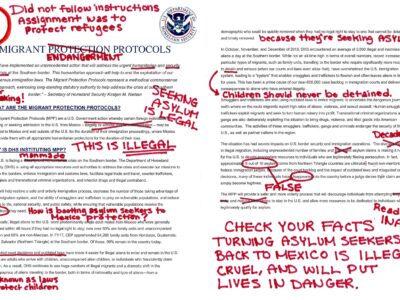Human Rights First Researches Asylum System at U.S. – Mexican Border
Though the debate around immigration reform continues in Washington, D.C., last week Human Rights First left the capital and headed for the hot, humid, and windy Rio Grande Valley to see firsthand some of the challenges along the Mexican border. Our trip, the first in a series that will includes Texas, Arizona, and California, was to learn more about the increase in requests for protection along the southern border and strategies for safeguarding the integrity of the system. In the past few years there has been an uptick in protection requests along the border, leading to questions about whether migrants may be abusing the asylum system to enter the country only to disappear into our communities. During our visit we spoke with government officials, service providers, and those who are seeking asylum in the U.S., to better inform Human Rights First’s recommendations for ensuring that asylum seekers have access to protection maintaining the integrity of our immigration system.

Pedestrians crossing at the Hidalgo Port of Entry.
In our many meetings, we heard about the challenges facing asylum seekers who are detained along the border in Texas. We spoke to individuals who reported that they had fled from violence and attacks in Central America and Mexico, as well as African asylum seekers who had been detained for months in prison-like conditions along the border. These reports were consistent with the information we have learned from our own pro bono work with asylum seekers who came to this country through the southern border. Legal service providers along the border are overstretched and doing their best to address at least some of the needs, but many individuals go unrepresented. Many individuals, are detained in facilities hours away from potential legal counsel, and without a funded Legal Orientation Program in place.

Approaching the McAllen Hidalgo International Bridge connecting Hidalgo, Texas with Reynosa, in Mexico.
During our visits with immigration officials in south Texas, we learned a lot about the challenges in responding to the increase in protection requests and the overall increase in apprehensions in the area. These include lack of adequate space to conduct initial border interviews, lack of sufficient and appropriate space for holding individuals during initial border processing interviews, overwhelming case loads, and the need for cooperation and collaboration between multiple U.S. agencies.
Near Harlingen, we met with the extraordinary sisters of the La Posada Providencia shelter, who provide care, stability, and safety to asylum seekers who otherwise might be held in immigration detention for months. They also provide shelter to refugees who have been detained for months in prison-like detention facilities but are released after being granted asylum. The sisters and their volunteers help these refugees to start a new life in the United States.

The McAllen Border Patrol station, where those apprehended between ports of entry and in the interior are processed.
Our visits and interviews were informative, and they painted a challenging situation with few simple answers. Solutions will require a meaningful commitment of resources, interagency collaborations, and very real political will. And while our research is still ongoing, our preliminary recommendations include:
- Adequate resources for the U.S. Citizenship and Immigration Services (USCIS) Asylum Office, so asylum officers can conduct prompt credible and reasonable fear screenings in person, eliminating backlogs (in both the screening and affirmative asylum processes) that can be a magnet for abuse.
- Adequate resources for immigration judges. The Executive Office for Immigration Review’s funding has for years lagged behind funding for Department of Homeland Security (DHS) enforcement, apprehension, and detention, resulting in a crushing caseload and backlogs that can encourage abuse.
- Expansion of the Legal Orientation Program, which provides critical legal information presentations to detained immigrants but currently reaches only 25 of ICE’s approximately 250 facilities.
- Adequate resources for more strategic and national use of alternatives to detention so that an individual determined to be eligible for release from a facility in Texas could – where necessary to assure appearance – be placed into an alternative to detention program in the part of the country to which he or she is moving. Cost-efficient and effective alternatives are widely being turned to by criminal justice systems, including in Texas where the Texas Public Policy Foundation (home to Right on Crime) has expressed support for alternatives due to the cost-savings they create.
- Increased coordination among Department of Homeland Security components so that Immigration and Customs Enforcement (ICE), Customs and Border Protection (CBP), and USCIS can work together more closely – from the onset of a developing challenge – to address the many coordination issues arising from an increase in caseload.
This is just the beginning. We’ll continue to speak to more immigration officials, non-profit service providers, and individuals seeking protection. The solutions may not be easy, but they should be rights-respecting, fair, and pragmatic policies that facilitate U.S. compliance with international refugee and human rights commitments and strengthen the integrity of the U.S. asylum and immigration systems. As immigration reform proposals continue to be debated and discussed in Washington D.C., we should not forget America’s long history of protecting the persecuted.

